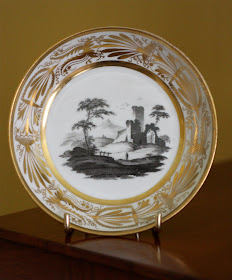Or are they Barr, Flight & Barr? I wonder . . .
This week I am featuring three handsome saucers from a set of six that we own, decorated with black transfer scenes of various romantic subjects and surrounded by painted gilt decoration in the classical taste. Two of the saucers feature a large Gothick castle in a parkland setting, two feature a rugged lakeland view with a fisherman, and two depict a picturesque ruin in a hilly landscape with a passing figure. I am not exactly sure where we bought the saucers, but I believe it was from a dealer in Hudson, New York, who has since gone out of business. I think we got them thirteen or so years ago.
I believe these saucers were possibly made in one of the factories of the Flight & Barr partnerships, active in Worcester, England, from 1792-1840. Known as Flight & Barr from 1792 to 1804; Barr, Flight & Barr from 1804 to 1813; and Flight, Barr & Barr from 1813 until 1840, the factories produced some of the handsomest porcelains made in England during the period, meriting their Royal Warrants as porcelain-makers to the (then) King Georges.
The saucers, which measure 5 3/8 inches across, look exceedingly well when displayed on either side of one of our French gilt-bronze clocks on one of the mantels at Darlington House. I am rather partial to their gold, white, and black decoration, and they are a great favorite of mine.
While I believe the saucers may well be a product of the Flight & Barr partnerships in Worcester, I am not able to confirm that definitively, as they are unmarked. If any of my readers have more information as to their origin, I would most gratefully appreciate it.
Photographs by Boy Fenwick



Reggie these saucers are exquisite! I am not an expert in this field so have no further information on the maker's.
ReplyDeleteThe last two are especially wonderful!
xoxo
Karena
Art by Karena
Hello Reggie:
ReplyDeleteOf all the saucers you have presented us with to date, we like these the best. We think that the monochrome images set inside the gilded rims are absolutely delightful.
We are no experts, far from it, but the saucers do look as if they come from the Worcester factory of Flight and Barr [the name in whichever combination the date of the saucer would fall]. Such topographical images were, we believe, typical of their work, with castles a particular avourite.
These would have to be my favorites as well... gorgeous!
ReplyDeleteNot the same, hardly even similar, but perhaps a bit resonant are the central grisaille panels in this tea set; since the paintings are attributed to Mr. Pennington, perhaps a search using his name might yield a connection to your saucers:
ReplyDeletehttp://www.vandekar.com/archives/details.asp?inventoryNumber=VM61130
They make perfect landscapes for one of Jane Austen's novels. Perhaps the section of Pride and Prejudice where Elizabeth Bennett travels with her aunt and uncle, taking in the countryside, ending up at Pemberley.
ReplyDeletexox Camilla
I love these. They are both bold and poetic.
ReplyDeleteI'm sure you know more than I when it comes to English pottery, but I just wanted to add that I have a small plate, which I've been was told was made by New Hall, and which looks very similar to these. The center transfer on mine forms sort of a vague forest scene that doesn't match any of your saucers, but the gilding seems to be of the same design. This may mean nothing, though, as far as who made them. I wish I knew more.
ReplyDeleteDear Mr. Darling,
ReplyDeleteYour saucers are exquisite! Please don't ever invite me into your home as you may be missing these once I've departed. They could easily turn me into a kleptomaniac. I own a few pieces of Barr Flight (Flight Barr?) myself and although not all their early pieces were marked, you may want to again take a look at your saucers in good light to see if an incised B has been scratched onto the base somewhere. This could be very easily missed at first or even second glance. Just a suggestion.
Check out Spode pattern 558 in the British V & A Museum, London
ReplyDelete